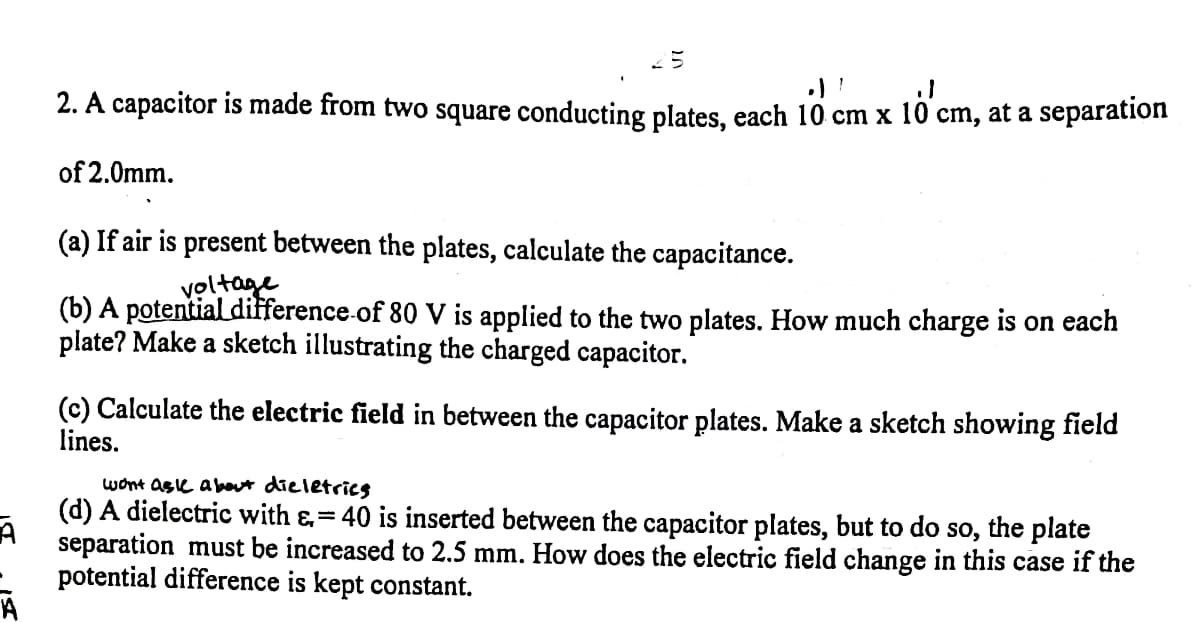2. A capacitor is made from two square conducting plates, each 10 cm x 10 cm, at a separation of 2.0mm. (a) If air is present between the plates, calculate the capacitance. voltage (b) A potential difference-of 80 V is applied to the two plates. How much charge is on each plate? Make a sketch illustrating the charged capacitor. (c) Calculate the electric field in between the capacitor plates. Make a sketch showing field lines.
2. A capacitor is made from two square conducting plates, each 10 cm x 10 cm, at a separation of 2.0mm. (a) If air is present between the plates, calculate the capacitance. voltage (b) A potential difference-of 80 V is applied to the two plates. How much charge is on each plate? Make a sketch illustrating the charged capacitor. (c) Calculate the electric field in between the capacitor plates. Make a sketch showing field lines.
Chapter8: Capacitance
Section: Chapter Questions
Problem 64AP: A capacitor is made from two flat parallel plates placed 0.40 mm apart. When a charge of 0.020C is...
Related questions
Concept explainers
Dielectric Constant Of Water
Water constitutes about 70% of earth. Some important distinguishing properties of water are high molar concentration, small dissociation constant and high dielectric constant.
Electrostatic Potential and Capacitance
An electrostatic force is a force caused by stationary electric charges /fields. The electrostatic force is caused by the transfer of electrons in conducting materials. Coulomb’s law determines the amount of force between two stationary, charged particles. The electric force is the force which acts between two stationary charges. It is also called Coulomb force.
Question

Transcribed Image Text:2. A capacitor is made from two square conducting plates, each 10 cm x 10 cm, at a separation
of 2.0mm.
(a) If air is present between the plates, calculate the capacitance.
voltage
(b) A potential difference-of 80 V is applied to the two plates. How much charge is on each
plate? Make a sketch illustrating the charged capacitor.
(c) Calculate the electric field in between the capacitor plates. Make a sketch showing field
lines.
wont ase about dieletricg
(d) A dielectric with &,=40 is inserted between the capacitor plates, but to do so, the plate
separation must be increased to 2.5 mm. How does the electric field change in this case if the
potential difference is kept constant.
Expert Solution
This question has been solved!
Explore an expertly crafted, step-by-step solution for a thorough understanding of key concepts.
Step by step
Solved in 3 steps with 3 images

Knowledge Booster
Learn more about
Need a deep-dive on the concept behind this application? Look no further. Learn more about this topic, physics and related others by exploring similar questions and additional content below.Recommended textbooks for you


College Physics
Physics
ISBN:
9781285737027
Author:
Raymond A. Serway, Chris Vuille
Publisher:
Cengage Learning

College Physics
Physics
ISBN:
9781305952300
Author:
Raymond A. Serway, Chris Vuille
Publisher:
Cengage Learning


College Physics
Physics
ISBN:
9781285737027
Author:
Raymond A. Serway, Chris Vuille
Publisher:
Cengage Learning

College Physics
Physics
ISBN:
9781305952300
Author:
Raymond A. Serway, Chris Vuille
Publisher:
Cengage Learning

Physics for Scientists and Engineers
Physics
ISBN:
9781337553278
Author:
Raymond A. Serway, John W. Jewett
Publisher:
Cengage Learning

Principles of Physics: A Calculus-Based Text
Physics
ISBN:
9781133104261
Author:
Raymond A. Serway, John W. Jewett
Publisher:
Cengage Learning

Physics for Scientists and Engineers with Modern …
Physics
ISBN:
9781337553292
Author:
Raymond A. Serway, John W. Jewett
Publisher:
Cengage Learning